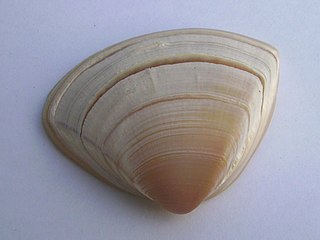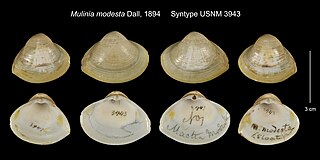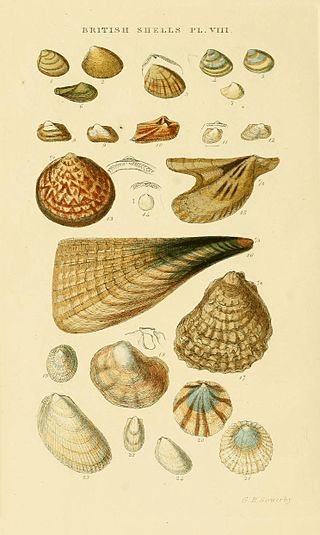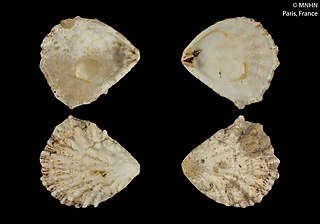
Ctenoides scaber, the flame scallop or rough fileclam, is a species of saltwater clam, a marine bivalve mollusc in the family Limidae. Despite their common name, flame scallops are not closely related to true scallops.

Isognomonidae is a family of medium-sized to large saltwater clams. They are pearl oysters, marine bivalve molluscs in the superfamily Pterioidea

Perna perna, the brown mussel, is an economically important mussel, a bivalve mollusc belonging to the family Mytilidae. It is harvested as a food source but is also known to harbor toxins and cause damage to marine structures. It is native to the waters of Africa, Europe, and South America and was introduced in the waters of North America.

Crassula aequilatera, known as the triangle shell, is a surf clam, a moderately large marine bivalve mollusc in the family Mactridae.

Mulinia modesta is a species of clam belonging to the family Mactridae.

Terebra taurina is a species of sea snail, a marine gastropod mollusc in the family Terebridae, the auger snails.

Dulcerana granularis, common name the granular frog shell, is a species of medium-sized sea snail, a marine gastropod mollusk in the family Bursidae, the frog shells.

Tellinella listeri, the speckled tellin, is a bivalve mollusc in the family Tellinidae, the tellins.

Tucetona pectinata, or the comb bittersweet, is a species of bivalve mollusc in the family Glycymerididae.

Limaria pellucida, the Antillean file shell, is a species of bivalve mollusc in the family Limidae. It can be found along the Atlantic coast of North America, ranging from North Carolina to the West Indies.

Plicatula gibbosa, commonly known as the Atlantic kitten's paw, is a species of bivalve mollusc in the family Plicatulidae.

Lucina amiantus, or the decorated lucine, is a species of bivalve mollusc in the family Lucinidae.
Pleurolucina leucocyma, or the saw-toothed pen shell, is a species of bivalve mollusc in the subfamily Lucininae of the family Lucinidae.

Periglypta is a genus of bivalves in the subfamily Venerinae of the family Veneridae.

Hysteroconcha dione or the elegant Venus clam, formerly known as Venus dione, is a species of bivalve mollusc in the family Veneridae, the Venus clams.

Paphia is a genus of saltwater clam, a marine bivalve mollusk in the subfamily Tapetinae of the family Veneridae, the Venus clams.
Stewartia floridana is a bivalve of the family Lucinidae that is chemosymbiotic with sulfur-oxidizing bacteria.

Lucinoma is a genus of saltwater clams, marine bivalve molluscs in the subfamily Codakiinae of the family Lucinidae.
Lamelliconcha is a genus of molluscs in the subfamily Callocardiinae of he family Veneridae.

Panopea bitruncata is a species of marine bivalve commonly known as the Atlantic geoduck or Atlantic geoduck clam. These clams like their more famous Pacific relative P. generosa have an enlarged siphon that can extend to great lengths or contract to just barely poke out of the shell. They are generally smaller in comparison to the Pacific species though still constitute a sizable mollusc as they cannot fully retract their siphon.
















